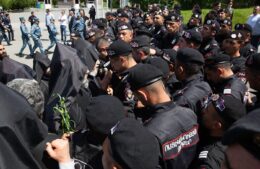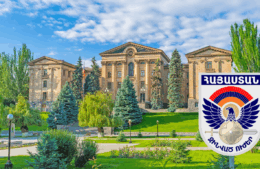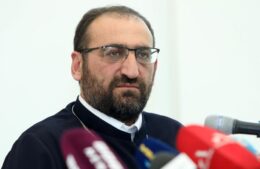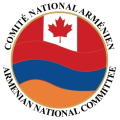“Aurora just refused to be reduced to a victim or to an object of history”: Inna Sahakyan, Director of Aurora’s Sunrise
- (0)

By Mariana Hristova
After celebrating its world premiere at the Annecy Festival, the animated documentary Aurora’s Sunrise locked horns in the international competition of the Golden Apricot International Film Festival and won the Silver Apricot award, while being presented in front of the Armenian audience for the first time. Sahakyan provides insights into the discovery of the character, as well as on archival material scouting.
Cineuropa: Aurora’s Sunrise refers to the successful silent film Auction of Souls (1919), which features the story of Aurora Mardiganian and contributed back then to international awareness of the atrocities of the Armenian genocide. Did you discover Aurora through the film?
Inna Sahakyan: In 2014, I stumbled upon an interview with her while going through the archives of the Zoryan Institute, an academic organisation that devoted itself to preserving the countless testimonies of genocide survivors. Before then, I had only a limited idea about her story through a translated version of her book Ravished Armenia, co-written with Henry Gates. But she was not well known in Armenia at the time, and I had no idea a film had been made about her. An incredible but also ordinary heroism shone through her personality, so, very intrigued, I continued my research and found a video interview with her in the Armenian Film Foundation. In that footage, she took out a large and yellowing poster from 1919, with a young Armenian woman in the center, and suddenly everything clicked into place — this genocide survivor was once a major celebrity! How come nobody nowadays, including me, had ever heard of her? I was fascinated by her story: the ways she repeatedly escaped the genocide, became a star and helped thousands of others like her.
Soon after I decided along with my producer that a film about Aurora had to be made, so we found out that the Armenian National Archives possessed surviving footage of the 1919 film. Only 18 minutes of the original three-hour-long epic had survived. While the film version of Aurora’s story had been altered in areas for dramatic effect, many of the scenes that survived matched the events that she describes in video testimonies.
Why have you decided to make an animated documentary instead of a costume fiction feature?
In our early discussions on how we could incorporate our footage into a feature film where we could speak to audiences while using archival documentary material, we could not imagine it another way. For me, the animation is an important part of the film, as it captures the epic quality of Aurora’s story and gives it a much wider appeal than a typical TV “talking-head” documentary. Most importantly, I think that animation is a very powerful medium for portraying something as difficult as trauma. A live-action portrayal of the genocide might have had such a horrific quality that a certain defensive distance between the viewers and the film could have arisen in order to detach the viewers from the essence of the story. But animation, as a medium that explicitly portrays the representation of an event and not the event itself, bridges this distance and allows for the viewer to be deeply engaged with the narrative and the thematic core of the story. At the same time, animation is a medium that can communicate the story’s colours, smells, tastes, and textures. Despite the difficulties that animation could impose on a filmmaker — this was my first time directing an animated film — a live-action costume fiction would have been a bigger challenge for this kind of story.
The film is very rich in its use of archival material, meaning both the oral history videos with Aurora and the historical photographs. Did you find all those in the Zoryan Institute and the Armenian Film Foundation?
We were also supported by Yerevan’s Armenian Genocide Museum Institute. Besides assisting me in locating resources about Aurora’s story, they provided me with important photographs and even helped me find them in other archives. The German Bundesarchiv played a special role as well in helping us find an archivist with rare footage of the Armenian orphans. Our team also worked tirelessly to search stock footage archives for supporting footage that could fit in our tight budget. All the public domain footage available from the US government archives was very relevant too.
Despite the tragic beginning of her life, Aurora’s fate is, by all means, a success story. After getting to know her personality during the process, what do you think is the reason for that?
Aurora dedicated her life to raising awareness of the genocide. Her amazing strength and devotion to her mission, and the way she overcame personal trauma and unspeakable pain in order to tell the world her people’s story, are inspiring. Her journey evolved from just a struggle for survival into one for humanity. Aurora just refused to be reduced to a victim or to an object of history. Maybe that is the secret to her strength.
Was it difficult to finance the film and how did you approach the search for funding?
It was an enormous challenge. The film financing system in Armenia is extremely limited compared to the ones in Europe or the United States. Besides its academic contribution, the Zoryan Institute also supported the film financially. But most of the film’s funding came from European co-production schemes, including Eurimages. However, it is very hard to enter the co-production world when your own country’s resources are so limited, thus we looked outside. We first started to work with our German co-producers Gebrüder Beetz Filmproduktion, and later Artbox from Lithuania joined us, doing most of the animation. It took us several years to finance the film but in the end, we have co-production with ZDF/ARTE’s Grand Format, the national film funds from both Armenia and Lithuania, and their national broadcasters.


















